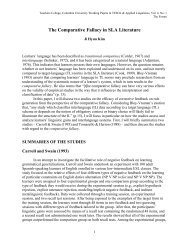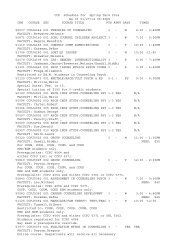UNICEF Mongolia - Teachers College Columbia University
UNICEF Mongolia - Teachers College Columbia University
UNICEF Mongolia - Teachers College Columbia University
Create successful ePaper yourself
Turn your PDF publications into a flip-book with our unique Google optimized e-Paper software.
CHAPTER 3: RECRUITMENT INTO TEACHING<br />
When we compare the findings from <strong>Mongolia</strong> with those for the league leader Singapore, two structural<br />
weaknesses become apparent:<br />
• Low stakes for admission. The test scores and the review criteria for admission into teacher<br />
educaon have become more exclusive over the past three years, but they sll are not sufficiently<br />
selecve. In <strong>Mongolia</strong>, fewer but beer and more highly movated students should be admied<br />
to teacher educaon studies. There is a risk that students enroll in teacher educaon as their<br />
second or third choice because they were not admied into more selecve degree programs.<br />
• Very low university-to-work transion rates. It appears that teacher educaon studies<br />
represent for many students a generalist degree that equips them for all kinds of professions and<br />
not necessarily for the teaching profession. Only 23.4 percent to 36 percent of graduates ever<br />
become teachers. The low university-to-work transion rate is endemic to teacher educaon<br />
studies not only in <strong>Mongolia</strong> but also in OECD countries. Typically, the transion rate is higher<br />
for primary school teachers than for secondary teachers, if for no other reason than the fact<br />
that secondary school teachers have greater opportunies as subject specialists who can work<br />
in a wide array of professions. Nevertheless, the low transion rate represents a huge waste<br />
of human capital as well as government resources. An alignment of the pre-service teacher<br />
educaon curriculum with pedagogical rather than generalist skills and knowledge would help<br />
teacher educaon students idenfy more strongly with the teaching profession and would most<br />
likely improve the transion rates.<br />
1<br />
2<br />
3<br />
4<br />
5<br />
6<br />
3.6. Summary and Recommendations<br />
This chapter examined the effecveness of pre-service teacher educaon in <strong>Mongolia</strong> based on the data<br />
that were made available by the <strong>Mongolia</strong>n State <strong>University</strong> of Educaon (MSUE). The main findings are<br />
summarized in the following:<br />
(1) Oversupply of teachers. Every seventh bachelor’s degree student in <strong>Mongolia</strong>, or 13.8<br />
percent of all undergraduate students, is enrolled in teacher training and educaonal studies.<br />
In 2010/2011, 20,989 students were enrolled in the four-year degree program. In the same<br />
year, however, only 1,171 teachers were newly hired. Clearly, there is an oversupply of qualified<br />
teachers who are not absorbed by the labor market.<br />
(2) The case study of MSUE. Approximately 53 percent of teacher educaon students study at<br />
MSUE. This study therefore focused on an analysis of MSUE data and selected three departments<br />
that, according to the senior management of MSUE, are very different from each other: the<br />
Department of Primary Teacher Educaon, the Department of Foreign Languages, and the<br />
Department of <strong>Mongolia</strong>n Language and Literature.<br />
(3) Recruitment into teaching indicators. This study was able to use four of the five indicators for<br />
effecve teacher educaon that are commonly used in teacher educaon research: admission<br />
rate and criteria, enrollment rate, compleon rate, and transion rate. There were no data<br />
available on the fih indicator, the retenon of newly qualified teachers in the profession two<br />
to five years aer their employment as teachers.<br />
TEACHERS IN MONGOLIA: AN EMPIRICAL STUDY ON RECRUITMENT INTO TEACHING,<br />
PROFESSIONAL DEVELOPMENT, AND RETENTION OF TEACHERS<br />
(4) Admission and enrollment rates. The required test scores have been raised over the past<br />
few years, making it more difficult to get accepted into teacher educaon. The average test<br />
57



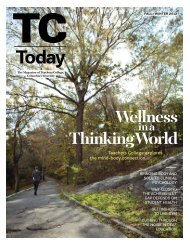

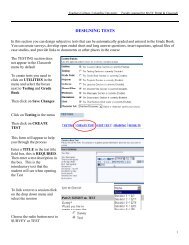

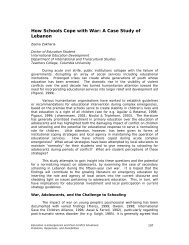

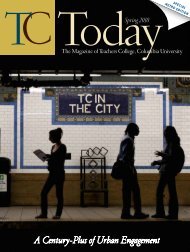
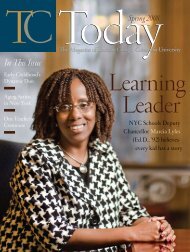
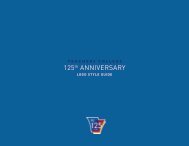


![TC Tod[...].pdf - Teachers College Columbia University](https://img.yumpu.com/27074883/1/190x252/tc-todpdf-teachers-college-columbia-university.jpg?quality=85)

